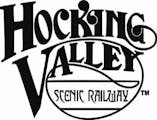The Hocking Valley Scenic Railway is a non-profit 501(c)(3) organization primarily operated by volunteer members and dedicated the restoration, operation and maintenance of historic railroad equipment for the education and entertainment of the general public. Since our founding in 1972, we have operated historic train rides out of Nelsonville and restored numerous historical locomotives, passenger cars and more.
OUR HISTORY
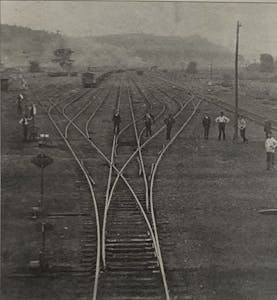
The Nelsonville Yard. From E.H. Miller’s collection.
The original Hocking Valley Railway
The history of the route we travel over dates back to the mid-1800s as large coal deposits were discovered in the Nelsonville area. The coal was initially shipped by wagon and then by canal, but both methods were too slow and inefficient. A faster and inexpensive method was needed, and the answer was a railroad. The railroad was founded in 1862 as the Mineral Railroad with the intention of building a line from Columbus to Athens, Ohio. In 1867, the name was changed to the Columbus and Hocking Valley Railroad, and construction began in mid 1867. The primary purpose for building the C&HV was to transport the Hocking Valley’s salt and coal out of the region. The famous brick industry arose to prominence not long after. The first train arrived in Canal Winchester in 1868, with regular passenger service established to Lancaster in 1869. The first freight train from Nelsonville arrived in Columbus on Aug. 17, 1869. As this particular train made its way from Nelsonville, there was a cannon on board that was fired as it approached each town along the way to let everyone know they were coming. Full service to Athens began in the summer of 1870. Eventually, the C&HV grew and became the Columbus, Hocking Valley and Toledo Railway before ultimately becoming the Hocking Valley Railway in 1899. Known as the “Buckeye Route” and “Columbus’ Railroad.”

The HV was the largest independent railroad located entirely within the state of Ohio. The HV connected Toledo and Lake Erie with the Ohio River towns of Pomeroy and Gallipolis.
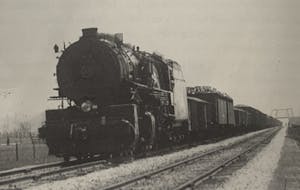
A Hocking Valley A-1 2-6-6-2 hauls a coal train toward Lake Erie in the late 1920s. From E.H. Miller’s collection
The Hocking Valley Railway was eventually merged into the Chesapeake and Ohio Railway on April 30, 1930, becoming the Hocking Division. Passenger service ended on the lines east of Columbus on Dec. 31, 1949, and many depots ultimately were torn down. Freight service dropped off over time, with the line through Nelsonville finally coming to an end in the early 1980s.
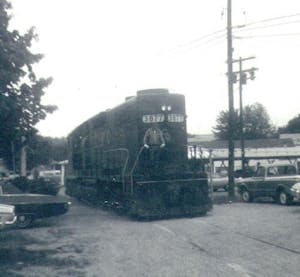
A C&O GP38 works Nelsonville Lumber in 1973. Photo by Dave Dupler.
The HVSR is formed
As mentioned above, service on the line decreased significantly as the years went by. In the late 1960s, some enthusiasts bought ex-Lake Superior and Ishpeming 2-8-0 No. 33 and moved it to Columbus for restoration.
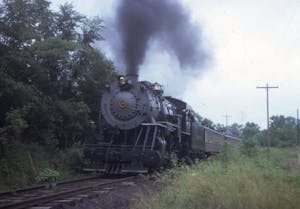
No. 33 steams along the Monday Creek Branch in the early 1970s. Photo by Bob Withers.
Several years later, the old Hocking Valley Monday Creek Branchline was purchased, and the 33 was moved to Nelsonville to begin a new career hauling passengers. The 33 was our sole motive power for our first decade of service, and the slightest of switching moves required the massive consolidation under steam. Our first diesel would not come until late 1981. As the years went by, we began acquiring more locomotives, passenger cars, cabooses, and other pieces of equipment.
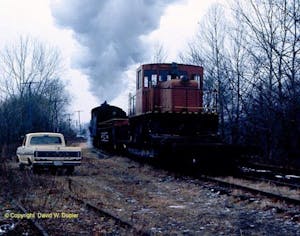
Our first diesel, ex-U.S. Army 45-tonner No. 7318, arrives in town in December 1981. Photo by Dave Dupler.
As freight service on the C&O died, the possibility of us being cut off from the national rail network loomed. We managed to acquire a sizable chunk of the line between Nelsonville and Logan and began operating on it around 1985. Funds were tight back then, requiring a loan to start each season, so the Monday Creek line had to be scrapped to help make ends meet.
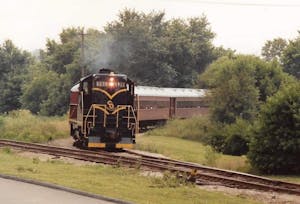
C&O GP7 No. 5833 became our primary motive power in the 1990s. Photo by Greg McDowell.
New boiler regulations eventually led to No. 33’s sidelining after the 1996 season, and it would be 19 years before there would be steam in the Hocking Valley again. The 33 was traded to Jerry Joe Jacobson for his Ohio Central in 2003 for GP10 No. 701. Today, 33 is safely displayed inside the Age of Steam Roundhouse Museum in Sugarcreek, Ohio. While we miss the old girl dearly, we know it is in good hands with our friends at Age of Steam.

GP10 No. 701 has been a part of our railroad for the last 20 years and works on and off with 5833. Photo by Pittsburgh Railfan.
Steam returned to the Hocking Valley in the form of Beech Bottom Power Company 0-6-0 No. 3 in 2015. While our vintage diesels remain our primary power, the little 0-6-0 is occasionally used to haul steam specials along our historic right of way. Please watch our website and social media pages for dates and times.
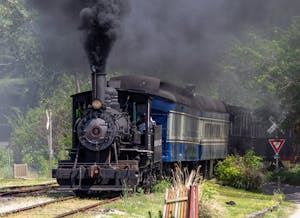
Aside from No. 3, the 21st century has been exciting for us so far with more historic cars being acquired/restored for excursion service, and the popular addition of dinner trains. Since 1972, the HVSR has grown and become one of the premier tourist railroads in Ohio. Of course, everything is a work in progress, as we deal with equipment dating back as far as 1916 and track dating back to the late 1860s. We can’t wait to see you on board our train soon!
Family fun is a train ride away! Make tracks to history!
